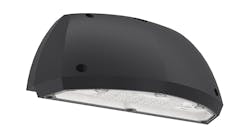Many lighting users in Europe might not be fully aware of it, but by the end of August, the EU will have banned most fluorescent light sources. That means — among other ramifications — that as countless millions of commercial tubes run their lifetime, the replacement choice will be LED products.
The fluorescent freeze-out could bring a revenue boon for LED vendors lasting several years. Ongoing use of fluorescent will not be illegal, but the sale of new general illumination tubes and lamps will be. The ban falls under a European Union directive known as RoHS, which stands for Restriction of Hazardous Substances in Electrical and Electronic Equipment.
RoHS has existed since 2003, applying to all sorts of goods. In fluorescent lighting the initiative targets mercury, a common and hazardous substance in linear fluorescent tubes and lamps (RoHS does not specifically take aim at the familiar environmental culprit CO2, or at energy efficiency, although its implementation should have benefits in those areas).
The purge picked up pace just over 10 days ago, when on Feb. 25, the EU booted out long-life versions of T5 and T8 tubes — the two most common office fluorescents, having 5/8-inch and 1-inch (8/8-inch) diameters respectively — and also eliminated compact fluorescent lamps (CFLs). The EU is ousting standard-life versions of T5 and 2-, 4-, and 8-foot T8 tubes on Aug. 25 (standard life is anything rated under 25,000 hours). On the same day, it is banning long-life CFLs. The dates are roughly six months to a year later in the U.K. depending on the product; standard life T8s will go on Sept. 1, and all the others will exit the market on Feb. 1, 2024.
LEDs Magazine has noted several recent references to the ban and its potential to boost sales of LED lighting. Vendors Fagerhult and Glamox, for instance, both foresee lively replacement activity. They also hope that the users might even take the opportunity to go for full internet-connected LED systems.
Curiously, there seems to be a lack of awareness of the directive. LEDs Magazine will now be providing periodic reports and advice from vendors and the lighting community in general. Our first stop is with Norwegian LED lighting supplier Glamox, where CEO Astrid Simonsen Joos agrees with our perception that RoHS is flying under the radar.
“Public awareness of the phase-out is still patchy,” Simonsen Joos said. “It's quite possible that some enterprises will wake up too late. That's why we urge businesses and municipalities to embrace it and seize the opportunity now to enjoy the benefits of energy savings and smarter ways of working.”
Glamox’s Anders Bru echoed that remark. As end user sales manager, he sits on the front line of the company’s efforts to provide fluorescent replacements, where many facility managers and other key individuals appear to be unacquainted with RoHS.
“We have had this on the agenda since last spring, out there informing the market, and we have been surprised that installers, consultants, and building owners — big building owners — did not know about it,” Bru told LEDs in a recent interview.
Not everyone has had their eyes closed. Statsbygg, an agency that manages Norwegian government property, recently replaced fluorescent tubes in offices and corridors at a building in central Oslo with about 1,300 Glamox LED luminaires. It cited RoHS as the driving factor, while also noting the added benefit of improving energy efficiency.
“We considered it was important to plan well ahead of the new directive and, at the same time, to reduce energy costs for lighting,” a Statsbygg spokesperson said.
But other end users have yet to realize that the next time a fluorescent tube fails, they might not be able to purchase a replacement. It is difficult to say exactly how many tubes are out there, but the number is probably easily in the hundreds of millions. In Norway alone, there are an estimated 10 million fluorescent luminaires, each with up to 4 tubes in them, according to the Swedish lighting research firm Svenska Belysningsbranschen.
“Awareness” might be the first big challenge for the lighting industry in the RoHS push. But it’s only the opening battle. Oslo-based Glamox warns that replacing fluorescent tubes with LED tubes might not be feasible in all installations. Rather, in many instances, new luminaires that house integrated LED chips on a board will be the way to go. LEDs will bring you more on this in a separate article soon.
MARK HALPER is a contributing editor for LEDs Magazine, and an energy, technology, and business journalist ([email protected]).
For up-to-the-minute LED and SSL updates, follow us on Twitter. You’ll find curated content and commentary, as well as information on industry events, webcasts, and surveys on our LinkedIn page and our Facebook page.






